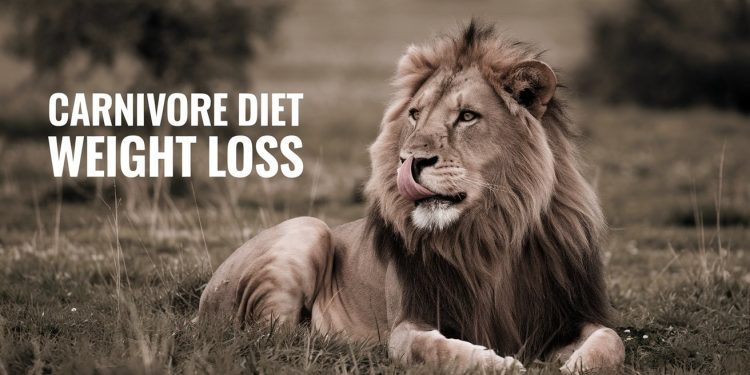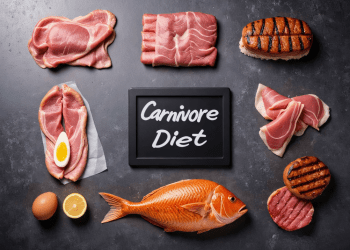The Carnivore Diet Weight Loss trend has been gaining significant traction in recent years, captivating the attention of health enthusiasts and those seeking effective weight loss solutions. This unique dietary approach revolves around the exclusive consumption of animal products, which means saying goodbye to fruits, vegetables, grains, and even dairy.
What is the Carnivore Diet?
At its core, the carnivore diet is simple: eat only meat, fish, and animal-derived products. Advocates of this diet claim that eliminating all plant-based foods can lead to various health benefits, including weight loss, improved mental clarity, and enhanced energy levels. By focusing solely on animal products, followers believe they can optimize their nutrient intake while minimizing potential toxins and anti-nutrients found in plants.
Why is it Gaining Popularity?
The rising popularity of the carnivore diet can be attributed to several factors:
- Simplicity: With no need to count calories or track macronutrients, many find the carnivore diet straightforward and easy to follow.
- Weight Loss Success Stories: Numerous individuals have reported significant weight loss results while following this diet, which has fueled interest and curiosity.
- Health Claims: Proponents often share personal testimonials highlighting improvements in conditions like obesity, diabetes, and autoimmune disorders.
In this article, we will explore the ins and outs of the carnivore diet, focusing on its principles, potential benefits for weight loss, and practical tips for those considering this unconventional eating plan. Let’s dive in!
Mechanisms of Weight Loss on the Carnivore Diet
The Carnivore Diet Weight Loss approach has generated considerable interest for its unique mechanisms that promote weight loss. In this section, we’ll dive into three primary mechanisms: the elimination of carbohydrates, increased protein and fat intake, and natural calorie control. Each of these factors plays a crucial role in how the carnivore diet can help you shed pounds effectively.
A. Elimination of Carbohydrates
How Cutting Carbs Puts Your Body in Fat-Burning Mode
One of the most significant aspects of the carnivore diet is its strict elimination of carbohydrates. By cutting out carbs, your body undergoes a metabolic shift known as ketosis, where it begins to burn fat for fuel instead of glucose.
- Metabolic Makeover: When carb intake is reduced, insulin levels drop significantly. Insulin is a hormone that regulates blood sugar levels and promotes fat storage. Lower insulin levels allow your body to start utilizing stored fat as its primary energy source.
- Weight Loss Boost: This metabolic shift helps with weight management by reducing hunger and cravings. As your body adapts to burning fat, you may experience more stable energy levels and fewer fluctuations in appetite. Studies show that low-carb diets can lead to greater weight loss compared to traditional low-fat diets. It’s like your body is finally getting the memo to let go of that extra baggage!

B. Increased Protein and Fat Intake
How Protein Keeps You Full and Boosts Your Metabolism
Another key mechanism behind the carnivore diet’s effectiveness for weight loss is the increased intake of protein and fat.
- Protein Power: High protein consumption is known to enhance feelings of fullness or satiety. When you eat protein-rich foods, your body releases hormones like peptide YY, which signals that you’re full, helping to reduce overall caloric intake. It’s like a built-in portion control system!
- Metabolism Boost: Protein has a higher thermic effect compared to fats and carbohydrates. This means your body expends more energy digesting protein than it does with other macronutrients. Approximately 20-30% of the calories consumed from protein are used in the digestion process itself. That’s like getting a metabolism boost with every bite!
| Macronutrient | Thermic Effect (%) |
| Protein | 20-30 |
| Carbohydrates | 5-10 |
| Fat | 0-3 |
C. Natural Calorie Control
How Nutrient-Dense Animal Foods Keep You Satisfied
The carnivore diet primarily consists of nutrient-dense animal products that contribute to natural appetite regulation.
- Intuitive Eating: Many followers of the carnivore diet report that they can eat until satisfied without constantly tracking calories. This intuitive eating approach allows you to listen to your body and respond to hunger cues rather than adhering to strict calorie counting. It’s like your body already knows what it needs!
- Cravings Crusher: The nutrient density of animal products means you get more vitamins and minerals per calorie consumed, which can help reduce cravings for less nutritious foods. This makes it easier to maintain a healthy weight without feeling deprived or constantly hungry. It’s like your body is finally getting the nourishment it craves!
The mechanisms behind Carnivore Diet Weight Loss are multifaceted, involving carbohydrate elimination, increased protein and fat intake, and natural appetite regulation through nutrient-dense foods.
By understanding these mechanisms, you can better appreciate how the carnivore diet may aid your weight loss journey while promoting overall health and well-being. It’s a win-win for your body and your waistline!
Common Challenges and Solutions in Carnivore Diet Weight Loss
Embarking on the Carnivore Diet Weight Loss journey can be exciting, but it’s not without its hurdles. Many people encounter challenges that can stall their progress or lead to frustration. In this section, we’ll explore some common reasons for weight loss stalls and provide practical strategies to overcome these challenges.
A. Reasons for Weight Loss Stalls
Metabolic Factors and Hormonal Imbalances
One of the primary reasons people experience weight loss stalls on the carnivore diet is metabolic factors. When you drastically change your eating habits, your body may take time to adjust. Hormonal imbalances, particularly with insulin and cortisol, can also play a significant role in weight management.
- Insulin Resistance: If your body has been accustomed to high carbohydrate intake, it may take a while for insulin sensitivity to improve. Elevated insulin levels can hinder fat burning, making it challenging to lose weight.
- Cortisol Levels: Stress can lead to increased cortisol production, a hormone that can promote fat storage, especially around the abdomen.
Insufficient Protein Intake
Another common culprit for weight loss stalls is insufficient protein intake. While the carnivore diet is inherently high in protein, some individuals might not be consuming enough to meet their body’s needs.
- Feeling Hungry: Low protein intake can lead to increased hunger and cravings, making it harder to stick to your diet and maintain a caloric deficit.
Lifestyle Factors: Stress, Sleep Deprivation, and Digestive Issues
Several lifestyle factors can also impact your weight loss journey:
- Stress: High stress levels can lead to emotional eating or cravings for unhealthy foods. It can also disrupt sleep patterns, further complicating weight loss efforts.
- Sleep Deprivation: Lack of sleep affects hormones that regulate hunger (ghrelin and leptin), leading to increased appetite and cravings.
- Digestive Issues: Some individuals may experience digestive discomfort when transitioning to a high-protein, low-carb diet. This discomfort can lead to decreased food intake or poor nutrient absorption.

B. Strategies to Overcome Weight Loss Challenges
Increase Protein Intake for Better Satiety
One effective way to combat weight loss stalls is by increasing your protein intake.
- Feeling Full: Higher protein consumption enhances feelings of fullness, which can help reduce overall caloric intake. Aim for a variety of animal products like beef, chicken, fish, and eggs to ensure you’re getting enough protein.
- Protein-Rich Foods: Incorporate foods such as steak, chicken thighs, salmon, and eggs into your meals. These not only provide ample protein but also contain essential nutrients that support overall health.
Incorporate Intermittent Fasting
Intermittent fasting (IF) is another strategy that can enhance fat burning on the carnivore diet.
- Enhanced Fat Burning: By restricting your eating window, you allow your body more time in a fasted state where it can burn fat more efficiently. Many people find that IF helps them manage hunger better while promoting weight loss.
- Flexible Approach: You don’t have to follow strict fasting protocols; even a simple 16/8 method (eating during an 8-hour window and fasting for 16 hours) can be effective.
Increase Physical Activity
Incorporating more physical activity into your daily routine—no matter how small—can significantly impact your weight loss journey.
- Find Small Ways to Move: Look for opportunities throughout the day to increase your activity levels. This could be as simple as taking the stairs instead of the elevator or going for short walks during breaks.
- Set Realistic Goals: Aim for at least 150 minutes of moderate aerobic activity each week combined with strength training exercises twice a week. This doesn’t have to be daunting; even light activities add up!
While challenges are a natural part of any weight loss journey—including on the Carnivore Diet Weight Loss plan—understanding the common pitfalls and implementing effective strategies can make all the difference.
By addressing metabolic factors, increasing protein intake, incorporating intermittent fasting, and boosting physical activity levels, you can overcome obstacles and continue progressing toward your weight loss goals with confidence! Remember, every step counts on this transformative journey!
Measuring Progress Effectively on the Carnivore Diet
When it comes to the Carnivore Diet Weight Loss, measuring your progress effectively is crucial for staying motivated and achieving your goals. While the scale can provide some insights, there are more comprehensive ways to track your journey. In this section, we’ll discuss the importance of looking beyond the scale and setting realistic expectations for your weight loss journey.
A. Beyond the Scale
Why Tracking Body Composition Matters
Relying solely on the scale can be misleading, especially when you’re following a diet like the carnivore diet. Instead of just focusing on weight, it’s essential to track changes in body composition. This means looking at how much fat versus muscle you have in your body.
- Body Composition Explained: Body composition refers to the different elements that make up your body, including fat mass, muscle mass, bone mass, and water weight. Understanding these components gives you a clearer picture of your health and fitness progress.
- Waist Circumference as a Key Indicator: One effective method for measuring fat loss is tracking your waist circumference. This measurement can be a better indicator of health than weight alone, as it reflects changes in visceral fat—fat stored around your organs, which is linked to various health risks.
Waist Circumference Progress
| Week | Waist Circumference (cm) | Change |
|---|---|---|
| Week 1 | 95 | – |
| Week 2 | 93 | -2 cm |
| Week 3 | 91 | -2 cm |
| Week 4 | 90 | -1 cm |
Methods for Measuring Waist Circumference
To measure your waist circumference accurately:
- Use a Flexible Measuring Tape: Stand up straight and wrap the tape around your waist, just above your hip bones.
- Find Your Natural Waist: Make sure the tape is snug but not compressing your skin. Take the measurement at the end of a normal exhale.
- Record Regularly: Track this measurement weekly or monthly to monitor changes over time.
B. Setting Realistic Expectations
Understanding Initial Weight Loss
When starting any new diet, including the carnivore diet, it’s essential to understand that initial weight loss often includes a significant amount of water weight.
- Water Weight Loss: When you cut carbohydrates, your body releases stored glycogen, which is bound to water. This can lead to rapid initial weight loss that may not reflect actual fat loss.
- Patience is Key: It’s important to remain patient and recognize that sustainable weight loss takes time. The goal should be gradual fat loss rather than quick fixes.
The Importance of Consistency
Consistency is crucial for achieving long-term results on the carnivore diet.
- Stick with It: Adhering to the diet consistently will help you see real changes over time. Remember that fluctuations are normal; focus on overall trends rather than daily numbers.
- Celebrate Non-Scale Victories: Pay attention to how you feel, how your clothes fit, and improvements in energy levels or physical performance. These non-scale victories can be just as motivating as seeing a lower number on the scale.
Measuring progress effectively on the Carnivore Diet Weight Loss journey involves looking beyond just the number on the scale. By focusing on body composition changes and setting realistic expectations, you can stay motivated and committed to achieving your health goals.
Remember, this journey is about more than just losing weight; it’s about building a healthier lifestyle that you can maintain for years to come!
Additional References
- Optimizing Fat and Protein Balance on a Carnivore Diet: Expert Guide – A comprehensive guide on balancing fat and protein intake while following the carnivore diet.
- Carnivore Diet: Meal Plan, Food List, and What You Should Know – An overview of the carnivore diet, including meal planning and potential benefits.
- What is the Carnivore Diet? – An informative article explaining the principles of the carnivore diet and its implications for health.
- The Science Behind the Carnivore Diet: Benefits and Risks – A detailed look at the science supporting the carnivore diet, including benefits and potential risks.
- Understanding Ketosis: The Role of Carbohydrates in Weight Loss – An exploration of ketosis and how reducing carbohydrates can aid in weight loss.
Conclusion: Navigating Your Carnivore Diet Weight Loss Journey
As we wrap up our exploration of the Carnivore Diet Weight Loss, it’s essential to reflect on the key points we’ve discussed regarding its effectiveness and the challenges that may arise.
Summary of Key Points
- Effectiveness: The carnivore diet can be a powerful tool for weight loss, primarily due to its ability to eliminate carbohydrates, increase protein intake, and promote natural appetite regulation. Many individuals have experienced significant fat loss and improved energy levels by adopting this unique dietary approach.
- Challenges: However, it’s important to acknowledge the potential challenges. Weight loss stalls can occur due to metabolic factors, hormonal imbalances, or insufficient protein intake. Lifestyle factors such as stress, sleep deprivation, and digestive issues can also impact progress.
- Measuring Progress: Instead of solely relying on the scale, tracking body composition changes—like waist circumference—and celebrating non-scale victories can provide a more accurate picture of your health journey.
Final Thoughts
Ultimately, balancing dietary choices with overall health goals is key. The carnivore diet may work wonders for some people, but it’s not a one-size-fits-all solution. Listen to your body, stay informed about your health, and be open to adjusting your approach as needed.
Remember, the journey to better health is not just about weight loss; it’s about fostering a sustainable lifestyle that nourishes both your body and mind.
As you navigate your own path on the carnivore diet, keep these principles in mind and embrace the journey ahead with confidence and curiosity!












